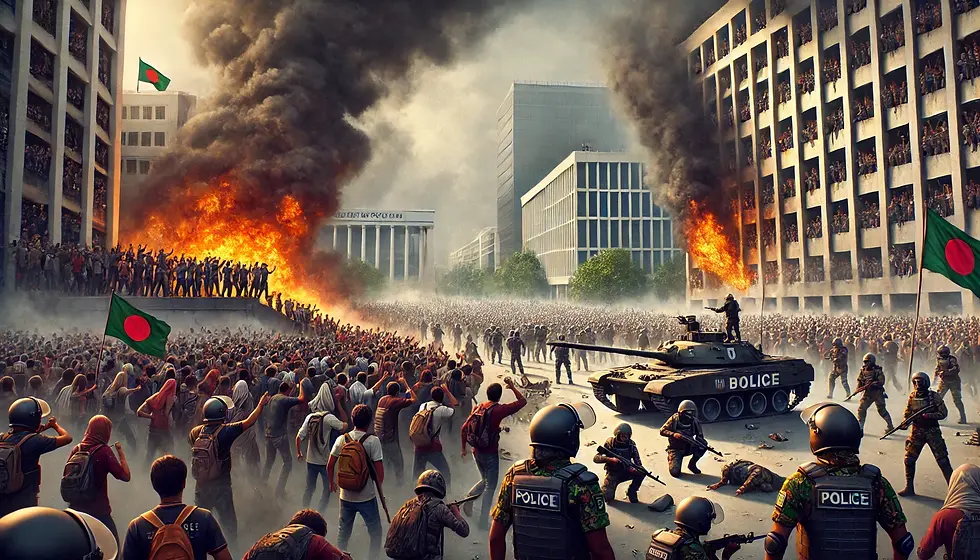Bangladesh Job Quota Protests: Understanding the Conflict and Its Implications
- Abhinand PS
.jpg/v1/fill/w_320,h_320/file.jpg)
- Aug 5, 2024
- 3 min read
Bangladesh Job Quota Protests: A Deep Dive into Recent Clashes and Their Implications
Introduction
Bangladesh has been rocked by severe violence as students protest against the government's job quota system. The situation escalated rapidly, resulting in a death toll surpassing 200 and widespread property damage. Prime Minister Sheikh Hasina's government has faced severe criticism for its handling of the crisis, with accusations of authoritarianism and human rights violations mounting. This article delves into the reasons behind the protests, the government's response, and the potential outcomes of this unrest.

The Genesis of the Protests
The controversy began with the Bangladeshi government's quota system, which reserved a significant percentage of government jobs for specific groups, including descendants of freedom fighters, women, and ethnic minorities. Critics argued that this system was unfair and discriminatory against the majority of the population. In 2018, the government initially scrapped the quotas, but a recent reinstatement of the system ignited renewed protests (India Today) (India Today).
The Escalation of Violence
The protests started peacefully in universities but quickly turned violent. Clashes between students and security forces resulted in the deaths of over 200 individuals, with thousands injured. The government responded with severe measures, including imposing a curfew, deploying the army, and shutting down internet services to curb the unrest (India Today) (Hindustan Times).
Political Dynamics
Prime Minister Sheikh Hasina has blamed opposition parties, particularly the Bangladesh Nationalist Party (BNP) and Jamaat-e-Islami, for inciting violence. Hasina claims that these groups aim to destabilize her government and disrupt the nation's progress. The opposition, however, accuses Hasina of authoritarianism and suppressing dissent (India Today).
Government's Response
In an attempt to quell the protests, the government reduced the quota from 56% to 7%, making 93% of government jobs open to merit-based candidates. Despite these changes, the discontent persists, fueled by broader issues such as stagnant job growth and high youth unemployment (India Today) (Hindustan Times).
Future Outlook
The ongoing unrest poses significant challenges for Bangladesh's political stability and economic growth. The student protests reflect broader societal frustrations that, if left unaddressed, could lead to more prolonged and widespread unrest. The government's ability to navigate these challenges will be crucial in determining the country's future trajectory (India Today) (Hindustan Times).
Conclusion
The recent protests in Bangladesh underscore the deep-seated issues within the country's job allocation system and the broader socio-political landscape. While the government's recent reforms may address some grievances, the underlying issues of economic disparity and political dissatisfaction remain. It is imperative for the government to engage in meaningful dialogue with protesters and consider comprehensive reforms to ensure long-term stability.
FAQs
1. What sparked the recent protests in Bangladesh? The reinstatement of the government's job quota system, which many viewed as unfair, sparked the recent protests.
2. How has the government responded to the protests? The government imposed a curfew, deployed the army, and reduced the job quota percentage from 56% to 7%.
3. Who are the main political players involved in this crisis? Prime Minister Sheikh Hasina's government and opposition parties, particularly the BNP and Jamaat-e-Islami, are the main political players.
4. What are the broader issues behind the protests? High youth unemployment and stagnant job growth are broader issues fueling the protests.
5. What are the potential future implications of this unrest? The unrest could lead to prolonged political instability and economic challenges if underlying issues are not addressed.



Commentaires